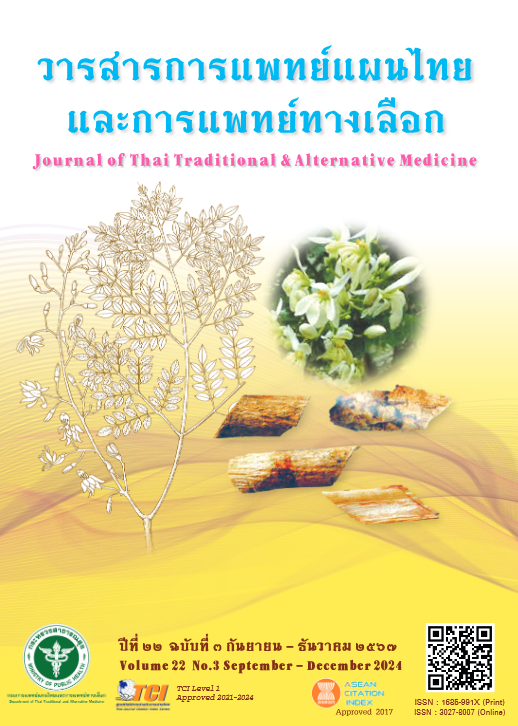Antioxidant and Antipathogenic Bacterial Activities in the Gastrointestinal Tract of Raw Musa Sapientum L. Crude Extracts
Main Article Content
Abstract
Introduction and objectives: Kluai namwa (Musa sapientum L.), is an annual plant in the MUSACEAE family. It has been found that raw fruits have an astringent taste and have properties in curing gastritis, stomach ulcer and relieves mild diarrhea. Ripe fruit has a sweet taste and has properties as a mild laxative, relieves bloating, and prevents anemia. In addition, it was found that extracts from the fruit and the peel of the ripe fruit are effective in treating diarrhea, and can inhibit the growth of some bacteria such as Escherichia coli, Staphylococcus aureus, and Serratia marcescens; and stem extracts can inhibit the growth of gram-positive and gram-negative bacteria and other bacteria that grow well in acidic conditions. Therefore, to support the treatment results, a laboratory study was conducted to test the antioxidant activity and the activity against certain bacteria that cause diarrhea.
Method: In this experimental research, raw bananas were extracted by maceration with 95% ethanol; and the extract was tested for antioxidant activity using DPPH assay, ABTS assay, FRAP assay, total phenolic compound and total flavonoid content. In addition, antibacterial activity was tested against three bacterial species such as S. typhimurium, E. coli and S. aureus using disc diffusion.
Results: It was found that raw banana extract has good antioxidant activity. When tested using the DPPH assay, ABTS, and FRAP methods, the IC50 values were found to be 0.612±0.008 mg/mL, and 0.023±0.000 mg/mL, and 39.892±11.659 mM Fe2SO2/mg, respectively. In addition, raw banana extract (95% ethanol) was found to have a higher amount of total phenolic compounds at 65.312±10.232 mg of gallic acid/mg of extract and total flavonoid content at 16.194±2.029 mg of catechin/mg of extract and has antibacterial activity against three strains of bacteria, including S.typhimurium, E. coli and S. aureus. The 95% ethanol extract of raw banana can inhibit E. coli and S. aureus the best, which has a minimum inhibitory concentration (MIC) and minimum bactericidal concentration (MBC) values of 6.25±0.00 and 12.5±0.00 mg/mL, respectively.
Discussion: Kluai namwa extract (95% ethanol) has antioxidant and effectively inhibit the growth pathogenic bacteria in the digestive system. So the results can be used as a guideline for developing and increasing the value of natural products to replace high-priced modern medicines and to develop them into medicines in the future.
Conclusion: The results suggest that the extract from kluai namwa has antioxidant properties and can inhibit the growth of S. typhimurium, E. coli, and S. aureus. This indicates its potential for developing natural products that could serve as alternatives to conventional medicines and may lead to the development of disease treatments in the future.
Article Details

This work is licensed under a Creative Commons Attribution-NonCommercial-NoDerivatives 4.0 International License.
References
Department of Medical Arts Public Health Office. General traditional medicine Thai Pharmacy major. [Internet]. 1999 [cited 2024 Jul 25]; 1(1): Available from: https://www.slideshare.net/slideshow/ss-39035258/39035258. (in Thai).
Faculty of Pharmacy Ubon Ratchathani University. Database of Northeastern Thai medicine [Internet]. 2011 [cited 2023 Dec 1]; 1(1): [20 screens]. Available from: http://www.thaicrudedrug.com. (in Thai).
Chaengdee P. Geographic information system application in surveillance of acute diarrhea in Bangkok Metropolis. Master of Science (Environmental Management). National Institute of Development Administration; 2010. (in Thai).
Chey WD, Wong BC. American College of gastroenterology guideline on the management of Helicobacter pylori infection. The American journal of gastroenterology. 2007;102(8):1808-25.
Mccoll KE. Clinical practice. Helicobacter pylori infection. The New England journal of medicine. 2010;362(17):1597-604.
Argudin MA, Mendoza MC, Rodicio MR. Food poisoning and Staphylococcus aureus enterotoxins. Toxins. 2010;2:1751–73.
Brzuszkiewicz E, Thurmer A, Schuldes J, Leimbach A, Liesegang H, Meyer FD, Boelter J, Petersen H, Gottschalk G, Daniel R. Genome sequence analyses of two isolates from the recent Escherichia coli outbreak in Germany reveal the emergence of a new pathotype: Entero–Aggregative–Haemorrhagic Escherichia coli (EAHEC). Archives of Microbiology. 2011;93(12):883–91.
Boyle EC, Bishop JL, Grassl GA, Finlay BB. Salmonella: from pathogenesis to therapeutics. Journal of Bacteriology. 2007;189(5):1489–95.
Chanchay N, Jantanan R. Efficiency of Thai herbs extract against diarrhea pathogen of young pig (Sus scrofa). Phranakhon Rajabhat Research Journal (Science and Technology). 2016;11(1):13-26. (in Thai).
Mungmai S, Muangkote S. Influence of garlic and shallot extracts on inhibition of Salmonella sp. as contaminated in egg. RAJABHAT AGRIC. 2021;20(1):33-41.
Tangmunkhong, P, Viriyarampa S, Chumsing S, Laopiem S. Efficacy of Thai medicinal plants on growth inhibition of Escherichia coli and Salmonella Typhimurium. Department of Veterinary Public Health, Faculty of Veterinary Medicine. Nakornpathom: Kasetsart University; 2019. (in Thai).
Pengpoo A, Jamjang K. The production of banana flour with antioxidant from 4 types of bananas. [internet]. 2016 [cited 2023 Nov 1]; Available from: https://research.kpru.ac.th/sac/fileconference/22872018-04-30.pdf. (in Thai).
Wetchakul P, Chonsut P, Punsawad C. Sanpinit S. LC-QTOF-MS characterization, antioxidant activity and in vitro toxicity of medicinal plants from the Tri-Than-Thip remedy. Evidence-Based Complementary and Alternative Medicine. 2022;1-10
Clinical and Laboratory Standards Institute [CLSI]. Methods for dilution antimicrobial susceptibility test for bacteria that grow aerobically. 2nd ed. USA: Wayne; 2018. 91p.
Thongchom C, Chakpa C, Songsang S, Phomyai P. Antioxidant activity and total phenolic compounds of bananas 5 species. Science Conference 2016; 2016 August 17-19; Faculty of Science and Technology, Kamphaeng Phet Rajabhat University. (in Thai)
Buchmann D, Schwabe M, Weiss R. Kuss Aw, Schaufler K, Schluter R, Rodiger S, Guenther S, Schultze N. Natural phenolic compounds as biofilm inhibitors of multidrug-resistant Escherichia coli the role of similar biological processes despite structural diversity. Frontiers in Microbiology. 2023;1-18
Phuphanee P, Thongekkaew J. Antibacterial activity of Banana blossom extract against pathogenic bacteria. Research and Innovation for Sustainable Development Goals in the Next Normal. 2022;125-35.
Cueva C, Arribas MVM, Alvarez PJM, Bills G, Vicente MF, Basilio A, Rivas CL, Requena T, Rodriguez JM, Bartolome B. Antimicrobial activity of phenolic acids against commensal, probiotic and pathogenic bacteria. Research in Microbiology. 2010;22(1):372-82.


